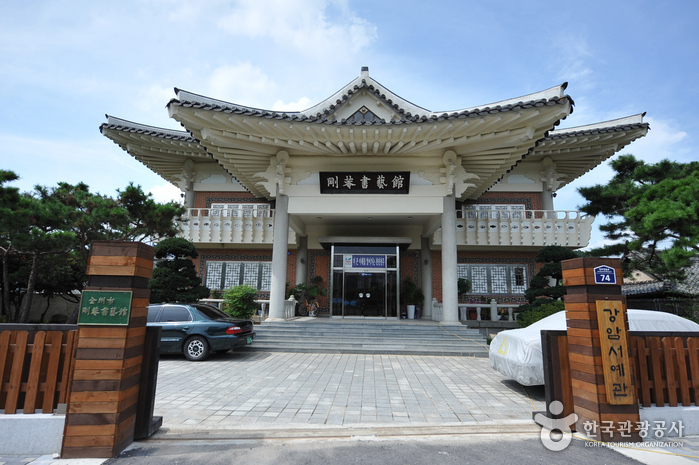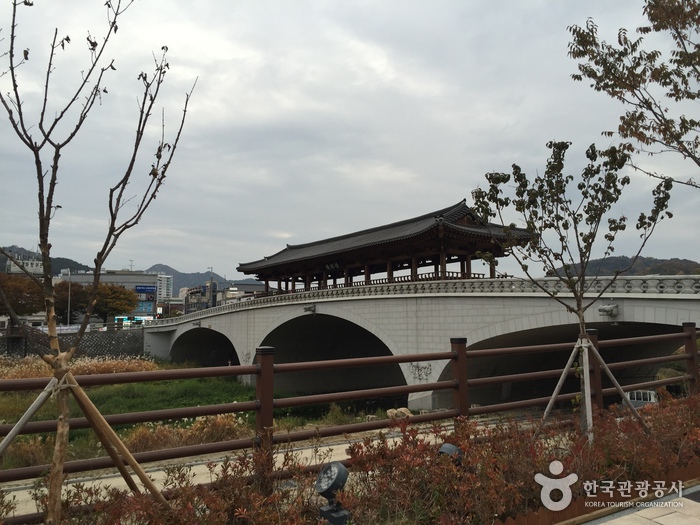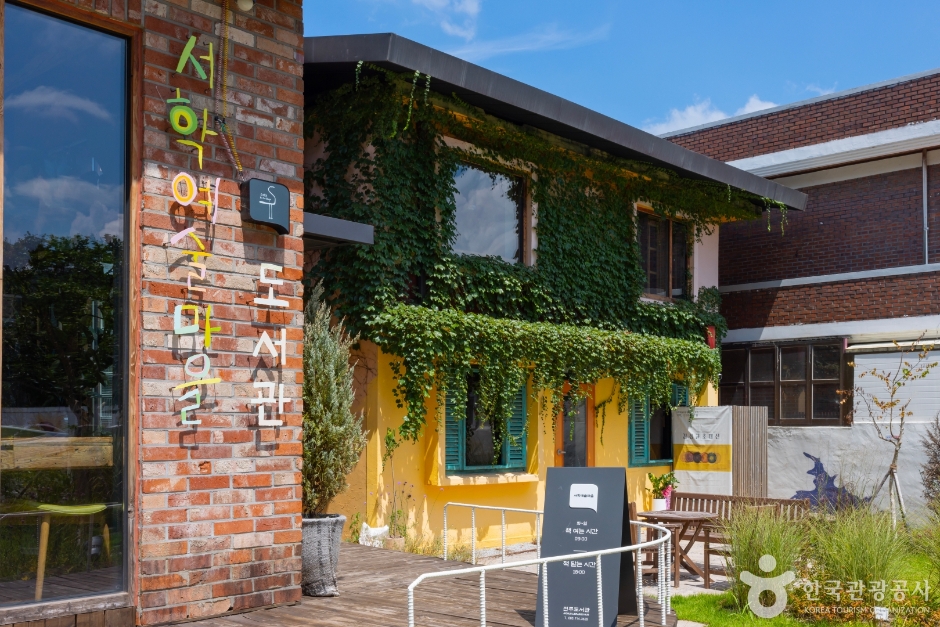Hanok Garden in Jeonju/ 전주한옥마당
.0M 2025-03-05
80-13, Jeonjucheondong-ro, Wansan-gu, Jeonju-si, Jeonbuk-do
+82-10-9494-4579
Jeonju Hanok Madang is located in the Jeonju Hanok Village. Jeonjucheon Stream and Namcheongyo Bridge are only one block away, whereas Gangam Calligraphy Museum, Jeonjuhyangyo Confucian School, Jeonju Hanbyuk Culture Center, Nambu Market, and Markbu Market Youth Mall are nearby. Major attractions of the Jeonju Hanok Village such as Gyeonggijeon, Jeondong Catholic Cathdral, and Omokdae are also within walking distance.
The main building and servants’ quarters of Jeonju Hanok Madang were built in 1941. It was renovated to retain the original shape of the traditional hanok, yet cozy and comfortable enough for modern people to use. Porches are attached to every room while Faith Room and Hope Room have additional inner floors attached to it. Inside the rooms are rafters, beams, wooden pillars walled with Hanji wallpapers, and ribs of lattice doors. There is a clean bathroom in each room.
The yard is the place the owner couple cherishes the most. Guests can enjoy the yard in any room just by opening the door. It is a combination of jar stands, a small pine tree, and small potted plants. Different flowers bloom from spring through autumn. It is such a pleasure to sit on the porch and appreciate the scene. In autumn, the persimmon tree bears fruits and dried persimmons hang from the eaves.
Hanokhyeyum[Korea Quality] / 한옥혜윰[한국관광 품질인증/Korea Quality]
23.0M 2024-04-07
42-5, Hyanggyo-gil, Wansan-gu, Jeonju-si, Jeonbuk-do
+82-10-5512-1226
Located in Jeonju Hanok Village, Hanok Hyeyum offers a traditional “hanok” (traditional Korean house) experience to its guests. The Korean term “hyeyum” means “thought,” and the hostel’s name pertains to the owners’ wishes of providing new feelings and thoughts to visitors. Its design faithfully brings the feel of the grain on the timber, which was possible with the participation of Daemokjang and Somokjang artisans specializing in hanok construction. The hanging sign at the entrance is carved by a Mokjogakjang, an artisan carpenter and holder of Intangible Cultural Property, and the same spirit of dedication and passion can be found throughout the building. There are six rooms in total, all Korean-style with exposed rafters, handwritten calligraphy, dainty furniture, and masterful teacups. Guests can also find a surprise welcome package of face mask packs. All rooms have modern and sleek bathrooms, while some rooms come with small attic spaces. Hanok Hyeyum also offers pickup services to solo female travelers from the Jeonju Bus Terminal or Jeonju Station, and a complimentary breakfast with a seasonal menu, including items like rice cakes, egg, sweet potato, fruits, and coffee.
Museo de Caligrafía Gangam (강암서예관)
37.6M 2024-04-07
Jeonjucheondong-ro 74, Wansan-gu, Jeonju-si, Jeonbuk-do.
Jeonju es considerada como una de las ciudades de la cultura y el arte de Corea, pero si desea sentir su ambiente artístico más de cerca y profundamente, visite el museo de caligrafía Gangam, situado en los alrededores de la Aldea Tradicional. El museo fue inaugurado en el año 1995 y es visitado por una gran cantidad de personas que aman el arte. En sus cercanías se encuentran varios lugares turísticos, considerados como valiosos patrimonios del país, la puerta Pungnammun, el santuario Gyeonggijeon, y hacia el este, la Escuela Confuciana Jeonju Hyanggyo, junto con el monte Omokdae, etc.
Este museo fue fundado en conmemoración y homenaje al gran maestro Song Seong-yong, cuyo seudónimo era “Gangam”, quien fue un famoso calígrafo nacido en esta región. Siendo el único museo exclusivo de la caligrafía en el país, expone un total de 1.162 piezas artísticas de las siguientes figuras claves del ramo: Chusa Kim Jeong-hui, funcionario público y calígrafo de Joseon, Lee Sam-man (seudónimo Changam), Kim Hong-do (seudónimo Danwon), Jeong Yak-yong (seudónimo Dasan), famoso filósofo religioso de Joseon, etc.
Por otro lado, a 200 m de distancia de este museo se inauguró la Sala Conmemorativa de la Revolución Donghak, por lo tanto, también podrá aprovechar la ocasión para conocer la historia de esta revuelta campesina.
Hakindang [Korea Quality] / 학인당 [한국관광 품질인증]
79.5M 2024-04-06
45, Hyanggyo-gil, Wansan-gu, Jeonju-si, Jeonbuk-do
+82-63-284-9929
Hagindang was built by the same master builder and carpenter who took part in building the palaces. It's the oldest traditional Korean house in Jeonju Hanok Village and a city/province-designated Folklore Heritage No. 8 situated in Hyanggyo-gil. It has a tall gate in the middle of high walls on either side, behind which are a large front yard with a pond as well as trees surrounding the pond. The house behind this pond is in perfect harmony with the landscape. Right next to the tall gate are a detached building called “sarangchae” and an area designated for experiencing Korean tradition, including another detached building called “byeoldangchae” behind the main building named “Hagindang.” Bonchaedaegwan, which consists of three rooms named “Baekbeomjisil,” “Haegongjisil,” and “Injaejisil” exude elegance and grace The “sarangchae” is a stand-alone building with two rooms with an open living room called "daecheong" in between, making it a perfect place for an entire family to stay. The "byeoldangchae" has a total of three rooms, and the first one (Room No. 1) has a tea room with three windows made of thin wooden frames on three sides. Hagindang serves traditional Korean breakfast like the head family.
ONEWWAL[Korea Quality] / 오뉴월[한국관광 품질인증/Korea Quality]
85.5M 2024-04-07
51-5, Hyanggyo-gil, Wansan-gu, Jeonju-si, Jeonbuk-do
+82-10-3670-2581
Onyuwol is a “hanok” guesthouse located in Jeonju Hanok Village. It is attached to a café that combines hanok and modern interior design and has enjoyed considerable popularity via word-of-mouth among young travelers. There are five rooms in total, which are furnished comfortably like their namesakes (the months of May and June). The rooms bear the hallmark elegance of hanok, from their exposed rafters to red clay floors, white cotton beddings, and muslin curtains. The furnishings remained minimalist, with only bedding, a small TV, electric kettle, and a basket containing a towel, hairdryer, and a hand mirror. The sleep-themed room names show that they are furnished with a restful stay in mind. Opening the door brings guests to the view of the peaceful garden. Nabijam and Kkotjam rooms have small attics that add a layer of elegance, while only the Danjam room is furnished with a bed. All rooms are equipped with bathrooms. Guests can also enjoy a complimentary cup of Americano in the café, and international guests have access to English services. Furthermore, its location makes it a good starting point for visits to Jeonju’s major tourist sights, such as Jeonjuhyanggyo Local Confucian School, Gyeonggijeon Shrine, Omokdae Historical Site, or the alleyways of the historical city.
Gyo Dong Sal Rae [Korea Quality] / 교동살래 [한국관광 품질인증]
115.2M 2024-04-07
66-1, Jeonjucheondong-ro, Wansan-gu, Jeonju-si, Jeonbuk-do
+82-10-9043-6743
Located at the entrance to Namcheongyo Bridge, which flows over Jeonjucheon Stream, Gyodongsalrae is a hanok structure built in 1971. It consists of the sarangchae (men’s quarters), anchae (women’s quarters), and byeolchae (detached House) and has ten guestrooms in total. While the sarangchae is situated near the road, the anchae and byeolchae are located to the rear of the house. Each building has a well-maintained flowerbed filled with seasonal flowers that harmonize perfectly with the beauty of the hanok.
The interior of the house is decorated with a variety of antiques, paintings, embroidery and knitting works, creating a cozy atmosphere. The ten rooms are of different sizes and styles including an ondol (Korean floor heating system) room, a room with a bed, and a darak (garret) room. The sarangchae consists of the Changpobang, Maehwabang, Baerongbang and Mokryeonbang rooms, of which the last two have a terrace with an open view. The anchae consists of a living room (sarangbang) and a room for two people. The byeolchae with a small courtyard has three large rooms with a capacity of four to six people and a separate space for relaxation and breakfast.
Pabellón Cheongyeonru del Puente Namcheongyo (남천교 청연루)
120.4M 2024-04-06
Cheongyeong-ro 40, Wansan-gu, Jeonju-si, Jeonbuk-do
El puente Namcheongyo es el puente principal que conduce a la Aldea Tradicional de Gyo-dong de Jeonju desde el barrio de Seohak-dong de la ciudad de Jeonju. A través de un importante proyecto de regeneración urbana, toda el área del puente Namcheongyo tuvo una renovación que mejoró la infraestructura disponible, agregando incluso el pabellón Cheongyeonru al puente. Los visitantes pueden disfrutar de una vista panorámica de la zona desde este pabellón de estilo tradicional hanok y al mismo tiempo refugiarse del sol en un día caluroso.
Hanokstory [Korea Quality] / 한옥이야기 [한국관광 품질인증]
166.7M 2025-01-02
83-14, Eunhaeng-ro, Wansan-gu, Jeonju-si, Jeonbuk-do
+82-10-9203-1111, +82-10-4166-7799
Hanok Story in Hyanggyo-gil in Jeonju Hanok Village is a traditional Korean house built over 60 years ago and was recently renovated to serve as a guesthouse. Thus, it boasts of modern convenient facilities but preserves most of the features of a traditional Korean house, which was home to the guesthouse owner and his wife for over 35 years. The couple put old books, LPs, old movie posters, Korean lunch boxes, and old television on display in every corner of the house to create an old look and finish. In the yard is a 50-year-old persimmon tree that provides cool shade during the summer and delicious persimmons in the fall. All the old items in the house have a story to tell, and that's why the owner named his guesthouse "Hanok Story."
At the entrance of the house is a Korean phrase meaning “Enjoy the Five Blessings (longevity, wealth, health, love of virtue, and peaceful death) generation after generation with the energy of the sun, moon, and stars.” That’s why the rooms are named “Geumbit (Golden Light),” “Haetbit (Sunlight),” “Dalbit (Moonlight),” and “Byeolbit (Starlight).” The phrase is also engraved on top of the door to the "Haetbit Room." There are a total of seven guestrooms -- four in the main building and the "Solbit Room," "Deluxe Room No. 1," and "Deluxe Room No. 2." All the rooms are furnished with bathroom, TV, and air conditioner. Deluxe Room No. 2 has a kitchen for the guests to cook. There is a garden of sowbread, balloon vine, and hydrangea in the yard.
There is also a cafeteria made of cypress wood in the yard. The walls are covered with post-its left by the guests as well as musical instruments and dolls. It's where tea and breakfast are served. Homemade Korean breakfast is served for free. A tea class is also available during the weekend upon reservation.
Yeohangga [Korea Quality] / 여행가 [한국관광 품질인증]
214.5M 2024-04-07
74-11, Eunhaeng-ro, Wansan-gu, Jeonju-si, Jeonbuk-do
+82-63-231-3040, +82-10-7742-6738
Yeohangga is a guesthouse owned and run by a woman who majored in early childhood education and who has been teaching children for over 20 years. The name means "A home for a happy trip," she says. It’s a unique guesthouse since the owner offers various traditional educational games. The cozy and comfortable guesthouse is a traditional Korean house built in March 2013 at a site where an old house used to be. The main building and detached building are divided by the ridge of the roof with beautiful rafters. There is another meaning to the name of the guesthouse: "a house where the woman is happy." She named it as such for a good reason. She used to live in Seoul when her parents advised her to move to Jeonju and run a guesthouse, leaving her husband and child behind. At first, she considered accepting only female guests, but it wasn't an option since most of the people visiting Jeonju are couples and groups of friends. Instead, she made sure the guesthouse is safe for women while building the house. Many female tourists traveling alone find this a great feature of the guesthouse because they feel safer during their stay. For one, she installed three doors for the rooms (1 transparent door, 1 opaque glass door, and a traditional Korean door). Not only do the guests feel safer; the rooms are also well-insulated thanks to the triple doors. The floors and walls are covered with traditional Korean paper coated with soybean oil, which is very environment-friendly. In the four rooms named “Spring,” “Summer,” “Autumn,” and “Winter,” there are many toys and materials for traditional Korean cognition games, such as “Chilgyo Game,” “Gonu Game,” and “Mabangjin.” It’s very likely that even Koreans have never heard of these games. The owner of the guesthouse chose these games specifically because they are perfect for children to play in a traditional Korean house. She teaches her little guests how to play the games. “Chilgyo Game” involves making a shape with 7 to 20 pieces, whereas “Gonu Game” is similar to the game of Chinese chess. "Mabangjin" is a type of IQ game that involves laying down a total of nine different numbers in three rows and columns so that the sum of the three numbers is identical when added horizontally, vertically, or diagonally. Many guests find these games interesting, and the owner of the guesthouse finds joy in teaching these games to as many families as possible. She recently took over another traditional Korean guesthouse called "Samrakheon" near the Jeonju Oriental Medicine Center. It's a stand-alone guesthouse for groups and families, and she uses the place to teach traditional games to more people.
Biblioteca de la Aldea Artística Seohak (서학예술마을도서관)
229.8M 2024-10-15
Seohak-ro 12-1, Wansan-gu, Jeonju-si, Jeonbuk-do



![ONEWWAL[Korea Quality] / 오뉴월[한국관광 품질인증/Korea Quality]](http://tong.visitkorea.or.kr/cms/resource/97/2651897_image2_1.jpg)
![Gyo Dong Sal Rae [Korea Quality] / 교동살래 [한국관광 품질인증]](http://tong.visitkorea.or.kr/cms/resource/71/2556371_image2_1.jpg)

![Hanokstory [Korea Quality] / 한옥이야기 [한국관광 품질인증]](http://tong.visitkorea.or.kr/cms/resource/20/2046320_image2_1.jpg)
![Yeohangga [Korea Quality] / 여행가 [한국관광 품질인증]](http://tong.visitkorea.or.kr/cms/resource/63/2572563_image2_1.jpg)

 Español
Español
 한국어
한국어 English
English 日本語
日本語 中文(简体)
中文(简体) Deutsch
Deutsch Français
Français Русский
Русский